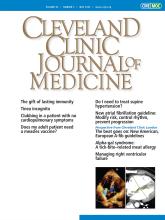Article Figures & Data
Tables
Stage Description Explanation 1 At risk of atrial fibrillation Modifiable risk factors: obesity, lack of fitness, hypertension, sleep apnea, excessive alcohol consumption, diabetes mellitus
Nonmodifiable risk factors: genetic factors (eg, variants in TTN, MYH7, MYH6, LMNA, and KCNQ1), male sex, old age2 Pre–atrial fibrillation Structural or electrical conditions that can lead to atrial fibrillation (eg, atrial enlargement, frequent atrial ectopy, short bursts of atrial tachycardia, atrial flutter, heart failure, valve disease, coronary artery disease, hypertrophic cardiomyopathy, neuromuscular disorders, thyroid disease) 3A Paroxysmal atrial fibrillation Intermittent and terminating within 7 days of onset 3B Persistent atrial fibrillation Continuous and lasting longer than 7 days 3C Long-standing persistent atrial fibrillation Continuous and lasting longer than 12 months 3D Successful atrial fibrillation ablation Freedom from atrial fibrillation after ablation 4 Permanent atrial fibrillation Not pursuing further attempts at rhythm control Based on information from reference 1.
Maintain or achieve a healthy weight Engage in physical activity Moderate alcohol consumption or abstain; avoid binge drinking Stop smoking Control hypertension Control hyperglycemia in diabetes Based on information from reference 1.
Lose weight if overweight or obese, ie, body mass index > 27 kg/m2 Start a standardized exercise program Stop smoking Minimize alcohol consumption or abstain entirely Optimally control comorbidities including hypertension and diabetes Based on information from reference 1.






